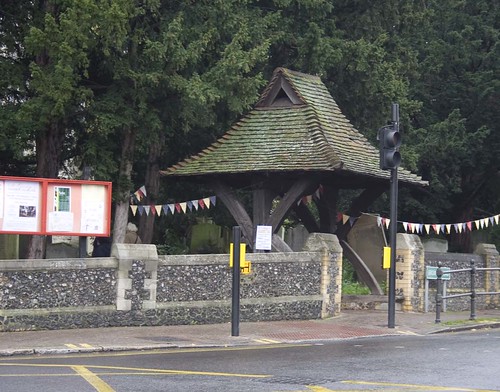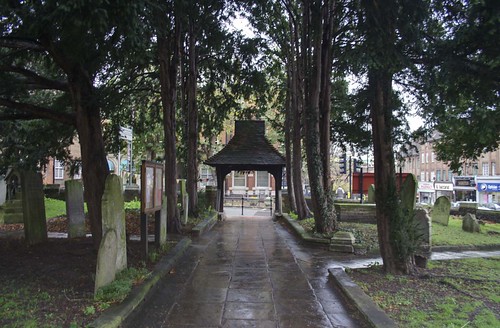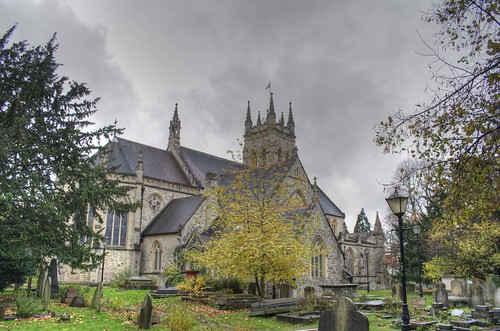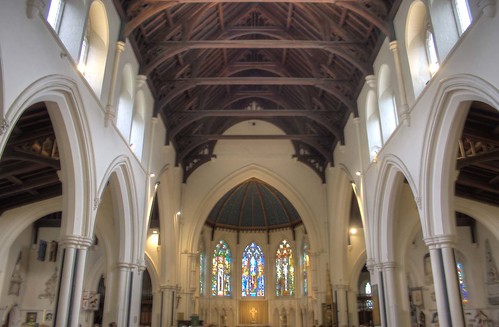If you approach an old church, mainly in towns and villages rather than cities, you might enter the churchyard through a small wooden gate with a pitched roof.
These small gatehouses though have a particularly macabre history, for this is the corpse gate – or lychgate as they are more commonly known. The term lych comes from Old English for corpse, and the corpse-gate was the route that the dead would take when being taken for burial in the churchyard.
Typically, the gate was where the clergy met the funeral congregation, and the shroud wrapped body would usually be rested on a table, or in larger gates, on a built in shelf, and there the priest would start the funeral rites.
The idea of the lychgate started around the 7th Century although most examples date from around the 15th century – the plague century. However, what is said to be one of the oldest surviving gates was erected in the 13th century, and this ancient relic can be found in South London, at Beckenham Junction marking the main entrance to St George’s Church.
This was restored in 1924 by a man who lost both his sons in the Great War. The restoration required the removal of the side walls and the restoration of the foundations, but the roof is essentially 700 years old.
A small plaque on one side marks the restoration, and one the other, if anyone glances up, a notice about the heritage of the gate.
You can see one interesting aspect of the popularity of the burials in the graveyard, as the soil is ramped up around the church – the result of many burials on top of each other.
Many of the lichgates in central London were removed as a consequence of the ban on burials within the City, and thus were seen as an unnecessary cost to maintain. So, you tend to find them more commonly in villages and smaller churches in towns.
Curiously, considering its deathly origins, in parts of England, the gate pays an important role in weddings, as the newly wed couple are required to leave by the same gate — often decorated with flowers — that they will pass back through in a few decades time.
Indeed, a new Lychgate was dedicated at St. Peter’s Church in Staines to mark the silver wedding anniversary of Sir Edward and Lady Clarke in Feb 1908.
I’m still not sure I would want to live in a house built by Lychgate Homes, or stay in the Lychgate hotel though. Shudder!
—
The lychgate in Beckenham marks the entrance to St George’s Church, a rather charming Victorian era building that was built over the site of the much earlier church. As nice as the church is, I am sad that the medieval predecessor was demolished to build it.
Talking of demolitions though, next to the church sits what looks like an old village green, but it is actually modern – the results of two impacts by V1 rockets during WW2. The ruined houses and shops were eventually cleared, and in the 1960s, the land purchased as a village green.
When I visited, the church was holding a local fete with stalls laden with cakes, knitted goods and Christmas cards. And it was packed, which is religious views aside, always a nice thing to see.












That’s quite a quaint little church for South London.
A hundred or so years ago it was not Greater London but Kent
What a lovely post: I knew about lych gates but had never heard them called corpse gates before. Lovely photographs!
Thank you for this most interesting blog. Some locals refer to St George’s as Beckenham Cathedral because of its size and musical traditions. It is, however, in Beckenham which was, until the formation of the GLC in 1965, in Kent , Beckenham Junction is merely a railway station.
Fascinating! Thanks Ian.
Very interesting Ian!
You do mention how newly wed couples leave by the gate, but in fact these gates had a more important role in 14th century Britain. In Chaucer’s ‘Cantebury Tales’ he mentions how the Wife of Bath had five men ‘at the gate’- i.e she has had five husbands.
In those days the wedding ceremony itself was performed *outside* the Church, at the gate to the churchyard. After the ceremony the couple and guests went into the church for mass.
This is quite interesting. Nice photographs. There are a number of lychgates scattered around Britain. My understanding is that bodies were received there for burial but I am not sure how much of the burial rite took place at the gate.
Lovely article. Is lych the same root as lynch?
There is a coffin rest in the Lychgate of St. Giles Church in Shipbourne, Kent. I had no idea of its significance prior to your article. Thank you.
I’ve learnt something. Fascinating
Interesting. I live near “Lydgate Lane” in Sheffield.
Sure enough, it runs past a cemetery. I wonder if it is a contraction of lych gate? It was also the surname of a poet c1400
I’m a Beckenham resident. St George’s is large and the rebuilding was due to the need for a larger church after the population grew rapidly when the railway arrived. I agree it’s sad to have lost the old church. This one lost its windows in the bomb blast and new ones were commissioned.
Thanks for the info about lych gates; the English word is very similar to the German word for a corpse, Leiche, so might be Anglo Saxon, I guess.
There is a church in Coulsdon village with a lydgate, opposite the village pond, green.
The Tudor Rose. stands just up the top of the road.
I have a photo. where we are standing underneath it, my niece Christning.
Very interesting site.
My local Church, St Peters, Harborne B17 has three lych gates.
Is this unusual.
Some parts date to Saxon times.